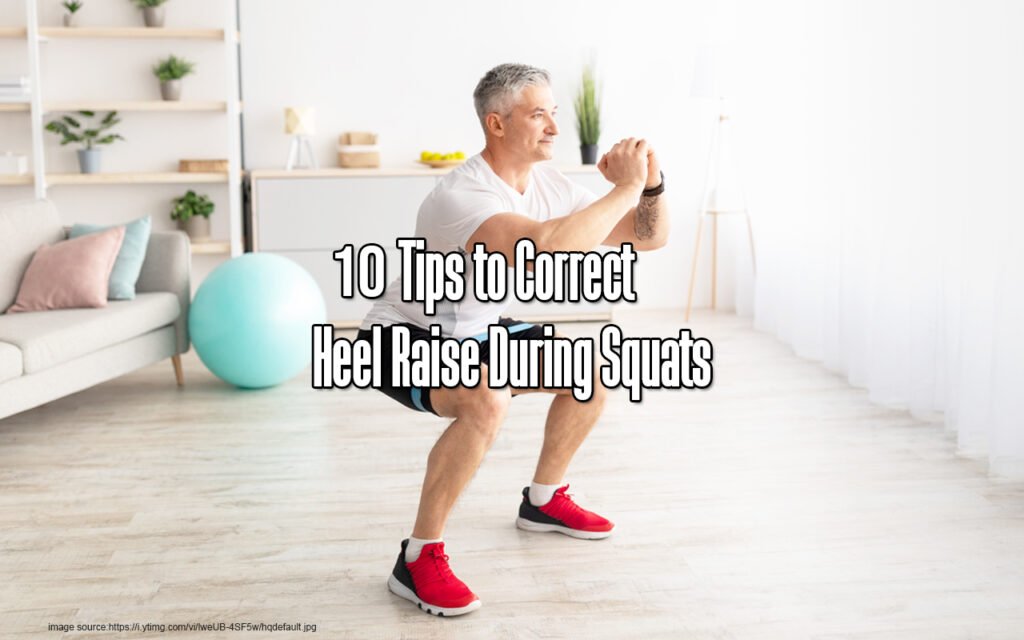Squats are a key exercise that targets multiple muscle groups, enhancing overall strength and stability. Heel raise during squats is a common issue that can affect form and increase the risk of injuries. Maintaining correct body posture is essential for maximizing the benefits of squats while minimizing the risk of injuries. In this article, we will explore 10 tips to correct heel raise during squats, helping you achieve better body posture and increase your overall squatting performance.
10 Tips to Correct Heel Raise During Squats
Table of Contents
1. Foot Placement
Start by positioning your feet shoulder-width apart. A stable base ensures proper weight distribution during squats, optimizing the movement. Learn the importance of foot placement and learn to optimize it for a more effective sitting experience in this exploration:
Shoulder-Width Apart:
To start, position your feet at a comfortable distance apart, approximately shoulder-width. The width of the base ensures stability by evenly distributing the load between both legs. Maintaining a balanced stance is crucial for control and to avoid strain on one side of the body.
Toes Pointed Slightly Outward:
Turning your toes slightly outward during squatting at a 5-20 degree angle assists in aligning the knees with the toes for proper form and stability. Natural rotation reduces knee joint stress & improves comfort and performance by accommodating the body’s biomechanics.
Weight Distribution:
Do proper weight distribution across your feet, from the heel to the ball of the foot, for maximum stability and balance. This ensures a strong connection with the ground, ensures stability, and prevents the heels from rising during the squat.
Arch Activation:
Engage your foot arches by lightly lifting them while keeping the rest of the foot firmly planted. Arch activation enhances balance and stability during squats by providing a supportive structure that reduces foot rolling and collapsing.
Varied Foot Positions for Different Squat Variations:
Different squat variations may require slight foot placement adjustments. For example:
- High Bar Squats: Keep your feet shoulder-width apart to maintain an upright torso.
- Low Bar Squats: Widen your stance slightly to accommodate the forward lean of this variation.
- Sumo Squats: To adjust an increased range of hip motion, just take a wider stance with your toes pointed out.
Experimentation and Individual Variations:
While general guidelines for foot placement exist, individual variations are common. Factors like hip anatomy, flexibility, and personal comfort play a crucial role. Experimenting with various foot positions is crucial for finding the most natural and effective stance that suits your body.
2. Toes Pointed Slightly Outward
Turn your toes slightly outward for better knee alignment during squats. This can help prevent your heel raise and promote a comfortable range of motion during exercises and activities. Here’s a comprehensive look at why this foot orientation matters, including the biomechanics involved and practical tips on how to implement it correctly for various movements and workouts:
Natural Alignment of Joints:
Pointing your toes slightly outward helps align the lower body joints in a natural and efficient position. This outward rotation aids in adapting to the hip joint’s natural curve, minimizing knee strain and enhancing the fluidity of squatting movements.
Reduced Shear Force on Knees:
Pointing the toes outward helps with proper knee tracking in squats. Ideal knee alignment involves keeping the knees in line with the toes. This alignment helps protect the knee joint by reducing shear force, lowering the risk of injuries like patellar tendonitis and ligament strains.
Enhanced Hip Range of Motion:
Pointing toes outward increases hip range of motion. This is especially helpful for those with limited hip mobility. Improved hip mobility allows for a deeper squat, effectively engaging the glutes and hamstrings.
Comfort and Stability:
Slightly rotating the toes outward often feels more comfortable during squats. Comfort plays a crucial role in enhancing stability and balance during movement, resulting in a controlled descent and ascent.
Prevention of Valgus Collapse:
Valgus collapse, which is the inward caving of knees during a squat. It is a most general problem that may increase the risk of injury. Outwardly pointed toes help prevent collapse and promote a safer more, structurally sound squat.
Individual Anatomical Considerations:
People have different levels of natural external rotation of the hip. The ideal toe-pointing angle varies among individuals. Try different angles to discover the most comfortable and biomechanically efficient position for your body during experiments.
3. Weight Distribution
Distribute your body weight across your foot, from heel to ball, for optimal balance and stability. This helps maintain stability and prevents excessive pressure on the toes, which can lead to heel lifting. Discover the importance of weight distribution and learn how to master it for improved squats in this comprehensive exploration:
Even Weight Distribution:
A successful squat requires even weight distribution across both feet. Distribute weight evenly between the heels and balls of your feet in all positions – starting, descending, and ascending to maintain balance during exercises. This ensures stability and prevents excessive pressure on any part of the foot.
Heel and Midfoot Emphasis:
There’s often a slight emphasis on the heels while both the heels and the balls of the feet are involved. Grounding your weight through the heels strengthens the connection with the floor, activating the posterior chain, including the glutes and hamstrings. This emphasis enhances squat power and stability.
Preventing Toe Dominance:
Avoiding excessive weight on the toes is crucial for squat stability and preventing potential heel rise. When weight is disproportionately shifted forward, it compromises balance and can strain the knees, leading to potential instability and increased risk of knee injuries. It’s essential to consciously keep the toes down and engage the entire foot for effective movement and stability.
Maintaining Arch Activation:
Proper arch activation in the foot requires even weight distribution. Keep the arch lifted for added support and stability. Arch activation helps maintain a strong foundation, preventing foot collapse and promoting proper alignment of ankles and knees.
Heel Stability and Ground Connection:
Grounding your heels ensures stability and a solid connection with the floor. This connection is crucial for generating power during the squat. It allows for efficient force transfer through the lower body and minimizes the risk of imbalance that could lead to heel raise.
4. Engage Core Muscles
A strong core is important for maintaining proper squat posture. Put your core muscles by drawing your navel toward your spine. This helps stabilize the spine and prevent forward tilting, which can lead to heel raise. Discover why engaging your core is crucial and learn effective techniques for doing so during squats:
Spinal Stability:
Core engagement is crucial for spinal stability during squats. The core muscles engage to maintain correct posture and prevent excessive leaning forward or rounding of the spine during the squat workout. Stability is important for protecting your back and reducing injury risk.
Neutral Pelvis and Lumbar Support:
A strong core helps maintain a neutral pelvis, preventing excessive tilting forward or backward. Neutral alignment optimally supports the lumbar region, effectively reducing lower back strain during squats.
Preventing Forward Tilt:
Engaging the core muscles during squats prevents excessive forward tilting of the torso. Forward tilt causes weight distribution issues, increased knee stress, & compromised form.
Transferring Power:
A strong and activated core provides a stable foundation for transferring power during squats. Efficient force transfer between the upper & lower body enhances squatting motion, resulting in increased power and control.
Enhancing Balance:
Engaging your core during squats is key to improving balance. A stable core is crucial for maintaining proper posture, preventing any sideways swaying or leaning. Balancing is crucial for precise squats and to minimize the risk of falls or injuries.
5. Use a Raised Heel Shoe
Try weightlifting shoes with a raised heel. These shoes enhance ankle mobility and offer a stable foundation for a range of exercises, including squats. We’ll delve into why using a raised-heel shoe is beneficial and how it impacts your squatting experience:
Improved Ankle Mobility:
A primary advantage is that raised-heel shoes enhance ankle mobility. The elevated heel facilitates greater dorsiflexion, the motion of bringing the top of the foot closer to the shin. Increased ankle mobility is especially advantageous for those with limited natural ankle range, allowing for a more comfortable and deeper squat position.
Optimal Squat Depth:
Raised heel shoes enhance ankle mobility, which helps achieve an optimal squat depth. You can easily descend into the squat and maintain an upright torso position with better dorsiflexion. Enabling a full range of motion and engaging specific muscle groups, like the quads and glutes, improves performance and strength.
Enhanced Quadriceps Engagement:
The raised heel changes squat biomechanics, focusing more on the quadriceps. Targeting and developing the quadriceps muscles can be beneficial for individuals looking to focus on muscle growth in that specific area. The altered angle promotes an upright torso and shifts the emphasis to the front of the legs.
Stable Foot Platform:
Weightlifting shoes offer a stable and solid platform for your feet. The flat and non-compressible sole provides excellent support for your feet, reducing the chances of instability during squats. A stable base is essential for maintaining proper form and balance during squats.
Increased Shin Angle:
The raised heel enables a more forward shin angle in the squat. This advantageous shin alignment with the torso promotes a smoother and more controlled descent. Improved alignment reduces knee joint stress and enhances the safety of squatting movements:
6. Focus on hip-hinging
Hinge at the hips to start the squat and bend your knees. Maintaining an upright torso during squats helps prevent the heel raise as you descend, ensuring proper form and stability. Let’s find the significance of hip hinging in squats for improved technique and efficiency.
Understanding Hip Hinging:
Hip hinging is an essential movement pattern of hip bending while maintaining a neutral spine position. This movement is crucial for squat mechanics as it maximizes activation of the posterior chain, including the hamstrings, glutes, and lower back.
Initiating the Squat:
Start the squat with a hip hinge, not a knee bend. Start by shifting your hips back when squatting, creating a hinge-like motion. This movement pattern optimizes load distribution, with the hips absorbing the initial impact.
Engaging the Posterior Chain:
Hip hinging activates and strengthens the posterior chain muscles, like the hamstrings and glutes. Engaging the muscles is vital for generating power and stability throughout the squat, both during the descent and ascent phases. A strong and activated posterior chain enhances squat performance by providing increased force and control.
Preventing Knee Dominance:
A common mistake during squats is letting the knees dominate the movement. Focusing on hip hinging helps maintain correct knee alignment and distribute force evenly between the hips and knees. This reduces knee joint stress and promotes correct muscle activation.
Maintaining an Upright Torso:
Hip hinging helps maintain an upright torso during squats. This is essential for spinal alignment and preventing excessive forward lean, which can cause lower back strain. An upright torso position enables safer and more controlled descent and ascent.
7. Utilize Resistance Bands
Adding resistance bands to your squat routine can help with knee alignment and prevent heel raise. Place the band just above your knees for maximum effectiveness. Discover the benefits of using resistance bands in your squat workouts and learn effective techniques in this detailed exploration:
Variable Resistance:
Resistance bands provide varying levels of resistance during squat exercises. Resistance bands provide versatile and effective strength training by offering increasing tension as they stretch, unlike traditional free weights. Dynamic resistance improves each phase of the squat, constantly challenging your muscles in the entire range of motion.
Targeting Stabilizing Muscles:
Resistance bands engage stabilizing muscles around the hips and knees. Squatting against the band’s tension activates stabilizing muscles, providing control and stability during the movement. This contribution is effective for improved joint stability and functional strength.
Encouraging Proper Form:
Resistance bands promote proper squat form. The tension from the bands encourages an upright torso and discourages excessive forward leaning. This prevents form errors and optimizes squat effectiveness by targeting intended muscle groups.
Activating Glutes and Hip Abductors:
Resistance bands are highly effective for engaging the glutes and hip abductors. Resistance bands are beneficial for maintaining proper hip abduction, promoting balanced muscle activation, and reducing the risk of knee valgus collapse during squats.
Incorporating Band Distal Attachment:
Attaching the resistance band around the knees boosts the activation of the hip abductors, improving their effectiveness. This configuration promotes proper knee alignment, preventing inward knee collapse during squat exercises.
8. Isometric Holds
Include isometric holds at various squat positions. Pausing at the bottom of the squat reinforces proper form and avoids uncontrolled descents that can cause heel raise. Let’s explore adding isometric holds to your squat routine:
Understanding Isometric Holds:
Isometric holds contract muscles without changing their length. In squats, isometric holds involve maintaining a specific position, like the midpoint or bottom, for a set duration without executing the upward or downward motion.
Midpoint Isometric Holds:
During the squat exercise, maintain the position when your thighs are parallel to the ground. It activates several muscle groups simultaneously. This isometric hold focuses on the quadriceps, hamstrings, and glutes, enhancing muscle endurance and strength in the half-squat position.
Bottom Position Isometric Holds:
The “hole” in the squat refers to the bottom position, where the thighs are below parallel. It requires maintaining a static squat position. This challenges the muscles differently, focusing on the adductors, glutes, and lower back. This variation improves stability and strength in the deep squat position.
Benefits of Isometric Holds:
- Muscle Engagement: Isometric holds engage muscle fibers, promoting muscle activation and endurance. This extended contraction leads to more muscle recruitment than dynamic movements.
- Strength Development: Isometric holds build power by targeting joint angles involved in the hold. This is particularly helpful for strengthening the mid-range and bottom of the squat.
- Joint Stability: Isometric holds enhance joint stability by activating the muscles surrounding the joints to maintain a static position. This promotes better joint health and helps prevent injuries.
- Neuromuscular Adaptations: Isometric training enhances neuromuscular adaptations. It’s optimizing communication between the nervous system and muscles. This improved connection enhances control and coordination during squats.
Incorporating Isometric Holds into Your Squat Routine:
- Midpoint Holds: During a squat exercise, hold the midpoint position for a set duration after descending. Focus on maintaining control, stability, and proper form with an engaged core and an upright torso.
- Bottom Holds: Lower yourself into a full squat and hold the bottom position for a set time. Maintain proper form and engage your muscles during the hold for best results.
- Adding Variation: Try different durations for your isometric holds. Shorter holds (10-15 seconds) build explosive strength, while longer holds (30-60 seconds) enhance endurance and muscle activation.
- Progressive Overload: Slowly increase the challenge by introducing resistance to enhance isometric holds. You can achieve this by using a barbell in the squat rack or wearing a weighted vest.
9. Video Analysis
Record yourself doing squats from different angles and analyze the footage. The video analysis gains valuable insights into your form, identifying and addressing issues with heel raise for enhanced performance. Let’s delve into the importance of video analysis for squats:
Importance of Video Analysis:
- Visual Feedback: Video analysis provides visual feedback beyond the sensory experience of squatting. Watching squats from different angles helps you get an objective perspective on your form, making it easier to spot any deviations or errors.
- Form Evaluation: Recording your squats provides a valuable tool for evaluating and improving your form. It allows you to assess important factors like depth, alignment, and biomechanics, enabling you to identify areas for refinement in your squat technique.
- Real-Time Corrections: You can make immediate corrections to your form by reviewing video footage in real time or after the set. This on-the-spot feedback helps reinforce proper movement patterns and prevents the development of bad habits.
- Progress Tracking: Video analysis helps track progress over time. Recording your squats regularly helps track your progress, compare form and performance, and visually document your journey and achievements.
How to Conduct Video Analysis:
Positioning the Camera:
- Set up the camera to capture your squat from different angles, such as a side view and a rearview, for better analysis and feedback.
- To ensure stability during squats, securing the camera and preventing it from being knocked over is important. Using a tripod or a stable surface is recommended for this purpose.
Recording Full Sets:
- Record full sets of squats, capturing both the descent and ascent phases, to analyze your complete squatting movement effectively.
Reviewing Footage:
- Slow-motion playback is highly advantageous for detailed analysis. Many smartphones and video recording devices have built-in features for reviewing footage in slow motion.
Key Points to Evaluate
- Check for proper depth: When doing squats, it’s crucial to achieve an appropriate depth that considers your mobility and the type of squat you’re performing.
- Assess hip and knee alignment: Ensure proper alignment of your hips and knees by checking that they move in line with each other, avoiding any excessive inward or outward motion.
- Evaluate back position: Maintain a neutral spine during squats to prevent excessive rounding or arching of the back.
Common Issues Identified through Video Analysis:
- Heel Raise: Video analysis can help identify whether your heels are lifting off the ground during squats, which may indicate problems with weight distribution or ankle mobility.
- Knee Valgus Collapse: Identify if your knees are collapsing inward during the squat. It indicates possible weaknesses in the hip abductors.
- Forward Lean: Video analysis can help identify excessive forward leaning during descent, potentially causing lower back strain and compromising form.
- Uneven Weight Distribution: Weight distribution imbalances between the feet heels and balls are essential for maintaining stability.
Using Video Analysis for Specific Squat Variations:
- High Bar vs Low Bar Squats: Different squat variations may require form adjustments. Video analysis helps customize techniques based on the specific demands of high-bar or low-bar squats.
- Sumo Squats and Front Squats: Sumo squats and front squats help to identify challenges. It also improves the approach to these variations.
Incorporating External Feedback:
- Coach or Trainer Input: Getting input from a coach or experienced trainer can offer valuable insights during video analysis. They provide expert guidance and suggestions for improvement.
- Online Communities: Sharing your video footage with online fitness communities allows you to receive valuable feedback from a wider audience. Embrace diverse perspectives and tips from fellow lifters to improve your training.
10. Listen to Your Body
Pay attention to your body’s sensations during squats. If you feel discomfort or notice your heels consistently rising, take a step back and evaluate your form. Priority should be given to technique rather than lifting heavy weights to minimize the risk of injuries. Let’s discuss the importance of listening to your body when doing squats.
Body Awareness:
- Physical Sensations: Become more aware of physical sensations during squats. Be mindful of your muscles’ sensations, any discomfort, and the overall sense of strain or ease.
- Joint Feedback: Pay attention to your joints. If you experience any sharp or unusual sensations in your knees, hips, or lower back, address them promptly.
Respecting Pain vs. Discomfort:
- Discomfort as Normal: Discomfort during squats, especially when pushing your limits, is normal and may include muscle fatigue or a burning sensation.
- Distinguishing Pain: Differentiating between discomfort and pain is crucial. Persistent sharp pain, particularly in joints, serves as a signal to stop and assess. Ignoring pain can result in injuries.
Adapting to Your Fitness Level:
- Beginner Considerations: Start with bodyweight squats if you’re new to squats, then advance to more challenging variations gradually. Focus on learning proper form before adding significant resistance.
- Intermediate to Advanced Training: As you progress, pay attention to how your body reacts to higher weights and intensity. Gradual progression helps your body adapt and lowers the risk of overuse injuries.
Adjusting Intensity and Volume:
- Fatigue and Recovery: If you feel consistently tired or have a slow recovery, consider adjusting the intensity or volume of your squat workouts. Your body requires time to recover and adapt.
- Variability in Training: To prevent burnout, it’s essential to incorporate variability into your training routine. Balancing periods of higher intensity with lower-intensity sessions or active recovery can help maintain optimal performance and avoid overexertion.
Addressing Imbalances:
- Muscle Imbalances: Pay attention to any muscle imbalances that may become apparent during squats. If one side consistently feels weaker or less stable, consider incorporating unilateral exercises to address imbalances.
- Joint Mobility: Regularly assess joint mobility, particularly in the ankles, knees, and hips. Limited mobility can affect squat form and contribute to discomfort or strain.
FAQ’s
Q1. Why does heel raise occur during squats, and is it a cause for concern?
Heel raise during squats can occur due to factors such as limited ankle mobility, incorrect weight distribution, or muscle imbalances. Persistent issues with heel rise can negatively impact squat form and potentially strain the knees.
Q2. How does sitting improperly with heels raised affect the entire body posture?
Incorrect squat form, like heel raise, can affect posture negatively. This misalignment, if left unaddressed, can have a significant impact on various areas of the body, including the spine, shoulders, and hips. Addressing these issues is crucial for a healthy and upright posture, which in turn can have numerous benefits for overall well-being.
Q3. What are some practical tips to prevent heel raise during squats?
Focus on maintaining proper form by engaging core muscles, improving ankle mobility, and distributing weight evenly to prevent heel elevation. Also, try adjusting foot placement and depth during squats for improved stability.
Q4. Are there specific exercises or stretches to enhance ankle mobility for better squatting?
Yes, exercises such as ankle circles, calf stretches, and mobility drills can enhance ankle flexibility. Including these exercises in your warm-up routine can enhance squat performance and decrease the chances of heel raise.
Q5. How does footwear play a role in preventing heel elevation during squats?
It is important to select the proper footwear. Shoes with flat and stable soles offer improved support by distributing weight evenly and minimizing the risk of heel rise. High-top shoes or those with ankle support can also help.
Conclusion
Correcting heel rising during squats requires proper technique, strengthening exercises, and consistent attention to form. By implementing these 10 tips, you may improve your body posture, reduce the risk of injuries, and optimize the effectiveness of your squatting workouts. Remember, patience and gradual progression play a crucial role in the journey to master the art of squats and build a strong, stable foundation for your fitness.
Keeping your heels down during squats is crucial for maintaining proper form and maximizing the benefits of the exercise. Several factors can help the issue of rising heels during squats, including poor ankle mobility, weak hip muscles, and wearing inappropriate footwear for exercise. To address any challenges, try adjusting your routine and incorporating stretching exercises to maintain proper heel positioning. Heel plates can enhance stability and increase the range of motion during squats. It is especially for individuals with limited ankle mobility.
For additional insights on maintaining a well-rounded fitness routine, explore our comprehensive guide on the “8 Best Inversion Tables of 2024“. Inversion tables are a valuable addition to your fitness routine, promoting spinal health and overall well-being. Click here to discover the top options to improve your fitness journey and make an informed choice.








